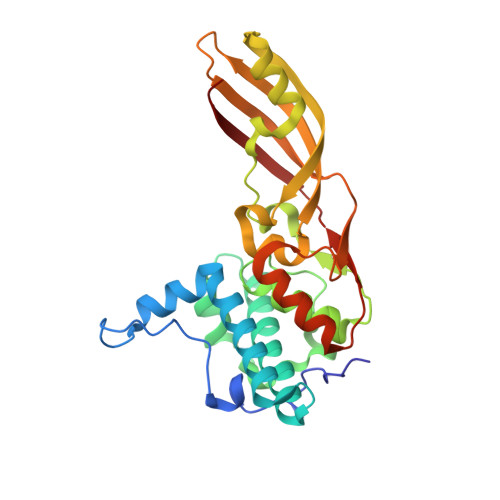Activation of Colicin M by the Fkpa Prolyl Cis- Trans Isomerase/Chaperone.
Helbig, S., Patzer, S.I., Schiene-Fischer, C., Zeth, K., Braun, V.(2011) J Biological Chem 286: 6280
- PubMed: 21149455
- DOI: https://doi.org/10.1074/jbc.M110.165274
- Primary Citation of Related Structures:
2XMX, 2XTQ, 2XTR - PubMed Abstract:
Colicin M (Cma) is specifically imported into the periplasm of Escherichia coli and kills the cells. Killing depends on the periplasmic peptidyl prolyl cis-trans isomerase/chaperone FkpA. To identify the Cma prolyl bonds targeted by FkpA, we replaced the 15 proline residues individually with alanine. Seven mutant proteins were fully active; Cma(P129A), Cma(P176A), and Cma(P260A) displayed 1%, and Cma(P107A) displayed 10% of the wild-type activity. Cma(P107A), Cma(P129A), and Cma(P260A), but not Cma(P176A), killed cells after entering the periplasm via osmotic shock, indicating that the former mutants were translocation-deficient; Cma(P129A) did not bind to the FhuA outer membrane receptor. The crystal structures of Cma and Cma(P176A) were identical, excluding inactivation of the activity domain located far from Pro-176. In a new peptidyl prolyl cis-trans isomerase assay, FkpA isomerized the Cma prolyl bond in peptide Phe-Pro-176 at a high rate, but Lys-Pro-107 and Leu-Pro-260 isomerized at only <10% of that rate. The four mutant proteins secreted into the periplasm via a fused signal sequence were toxic but much less than wild-type Cma. Wild-type and mutant Cma proteins secreted or translocated across the outer membrane by energy-coupled import or unspecific osmotic shock were only active in the presence of FkpA. We propose that Cma unfolds during transfer across the outer or cytoplasmic membrane and refolds to the active form in the periplasm assisted by FkpA. Weak refolding of Cma(P176A) would explain its low activity in all assays. Of the four proline residues identified as being important for Cma activity, Phe-Pro-176 is most likely targeted by FkpA.
- Max Planck Institute for Developmental Biology, Spemannstrasse 35, 72076 Tübingen, Germany.
Organizational Affiliation:

















